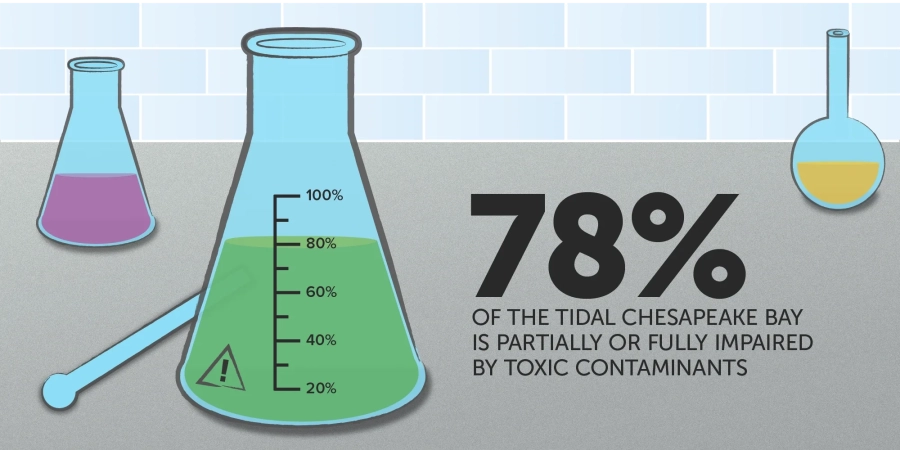Chemical Contaminants
Almost three-quarters of the Bay’s tidal waters are partially or fully impaired by pesticides, pharmaceuticals, metals and other chemicals, which can harm the health of both humans and wildlife.
Overview
More than three-quarters of the Chesapeake Bay’s tidal waters are considered partially or fully impaired by chemical contaminants. From the insecticides that are put on farm fields to the cleaners we use to disinfect our homes, contaminants can enter the Bay and its tributaries and harm the health of both humans and wildlife. Production bans have lowered the presence of some contaminants in the watershed, but others are still widely used today.
What kind of chemical contaminants are found in the Chesapeake Bay?
Two kinds of chemical contaminants can be found in the Chesapeake Bay: metals and organics.
The most common metal found in the watershed is mercury. A 2010 report from the U.S. Environmental Protection Agency (EPA) found the extent and severity of mercury contamination to be widespread in the watershed. Contamination with metals like aluminum, chromium or iron, on the other hand, is more often localized.
Common organic chemical contaminants include PCBs, PAHs and pesticides:
- PCBs, or polychlorinated biphenyls, act as a flame retardant in electrical equipment and have also been used in the production of inks, adhesives, sealants and caulk. Although PCBs have not been produced in the United States since a 1977 ban, the chemicals continue to enter the environment through accidental leaks, improper disposal and “legacy deposits.” Data indicates the extent of PCB contamination in the watershed is widespread.
- PAHs, or polycyclic aromatic hydrocarbons, form when gas, coal and oil are burned. PAHs are detected at varying concentrations across the watershed, with the highest reported in or near Baltimore Harbor and the Anacostia and Elizabeth rivers.
- Pesticides are applied to the land to prevent, destroy, repel or reduce pests. While agriculture accounts for about 75 percent of all pesticide use, 85 percent of U.S. households store at least one pesticide at home (and more than half of U.S. households store between one and five).
Pharmaceuticals and personal care products are an emerging concern in the region. These contaminants can appear in our landfills and our wastewater, and have been linked to behavior changes and reproductive disruptions in fish and other species.
How much of the Chesapeake Bay is impacted by chemical contaminants?

Show image description
The infographic shows three glass containers commonly used in a scientific laboratory. At the front and center, an Erlenmeyer flask containing green liquid is marked with a caution symbol. The flask's markings indicate it is just over 80% full. Next to the flask, text states that 84% of the tidal Chesapeake Bay is partially or fully impaired by toxic contaminants.
According to data submitted to the U.S. Environmental Protection Agency in 2018, 84 percent of the Chesapeake Bay’s tidal segments are partially or fully impaired by toxic contaminants.
While chemical contamination is often seen as a localized problem occurring in “hot spots” or “regions of concern,” metals, polychlorinated biphenyls (PCBs) and priority organics exceed water quality criteria in at least part of all of the tidal tributaries that deliver water to the main stem of the Bay. A technical report shows PCBs and mercury are particularly problematic in the region, and are considered widespread in severity and extent.
Where do chemical contaminants come from?
Four general sources push chemical contaminants into the Chesapeake Bay and its tributaries:
- Air pollution emitted by factories, power plants, cars, trucks, gas-powered lawn tools and other sources,
- Agricultural runoff,
- Stormwater runoff, and
- Wastewater discharged from industrial facilities and wastewater treatment plants into rivers and streams.
How do chemical contaminants harm wildlife?
Some of the most common chemical contaminants in the Chesapeake Bay region can persist in the environment for a long time. These contaminants build up in the tissues of fish and other organisms, moving through the food web in a process called bioaccumulation. During bioaccumulation:
- Small, bottom-dwelling organisms take up contaminants through skin contact or while feeding,
- Larger fish eat contaminated organisms and accumulate toxins in their tissues, and
- Birds, mammals and other wildlife eat contaminated fish.
Different contaminants can affect the survival, growth and reproduction of fish and wildlife in different ways. Exposure to PAHs, for instance, has been linked to the development of liver tumors in brown bullhead catfish; exposure to pesticides has been linked to eggshell thinning in wild birds; and several studies have shown that PCB concentrations in bald eagle eggs can contribute to their failure to hatch.
What are fish consumption advisories?
Fish consumption advisories are public health notices that warn people about the possible health risks associated with eating fish or shellfish from a certain waterway. Advisories are issued when there is concern that locally caught fish or shellfish could contain mercury, polychlorinated biphenyls (PCBs) or other chemical contaminants. These advisories are not meant to discourage people from eating fish and shellfish; instead, they are meant to minimize public exposure to contaminants.
Fish consumption advisories can be issued for the general public or for “sensitive” populations (like pregnant women, nursing mothers or children), and can include recommendations to limit the consumption of a certain species of fish or to avoid eating the species altogether.
Find a fish consumption advisory near you:
The following links will direct you to the fish consumption advisories currently issued by states in the Chesapeake Bay region:
How you can help
To lower chemical contaminants in the Bay watershed, consider using non-toxic pesticides or chemical-free cleaning and personal-care products. You can also follow safe and legal disposal methods for paint, motor oil and other household chemicals, and keep pharmaceuticals out of our waterways by returning unused medicine to a consumer drug return location or fouling it with coffee grounds or cat litter before putting it in the trash.
